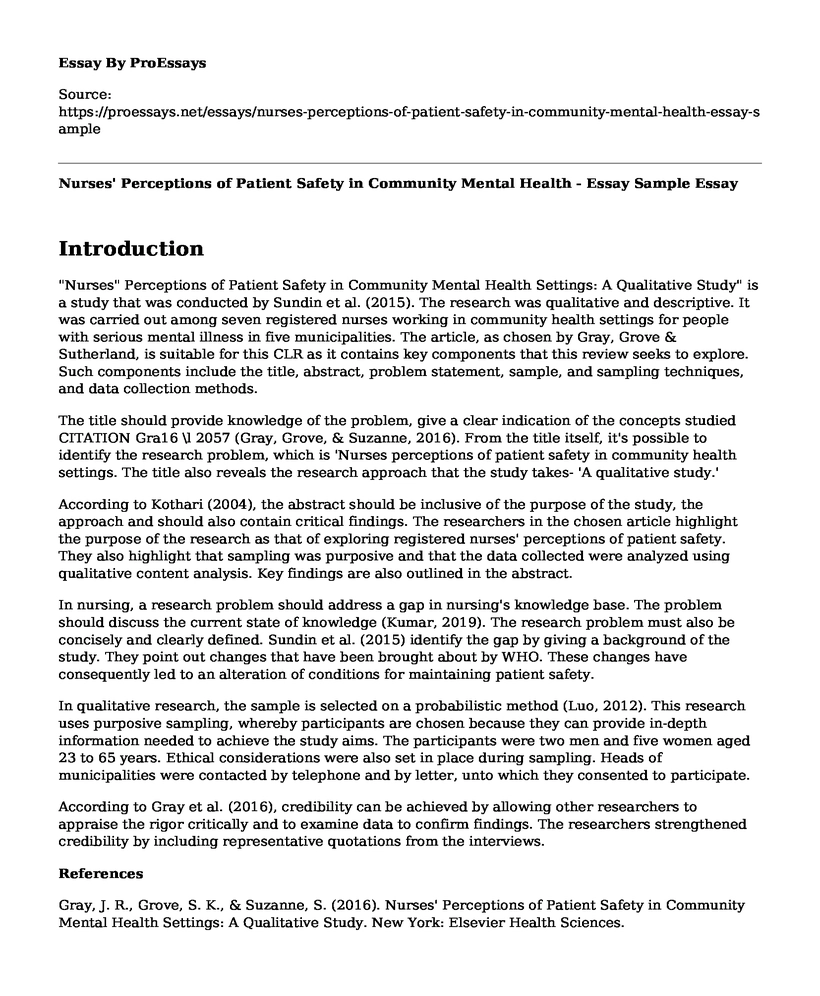Introduction
"Nurses" Perceptions of Patient Safety in Community Mental Health Settings: A Qualitative Study" is a study that was conducted by Sundin et al. (2015). The research was qualitative and descriptive. It was carried out among seven registered nurses working in community health settings for people with serious mental illness in five municipalities. The article, as chosen by Gray, Grove & Sutherland, is suitable for this CLR as it contains key components that this review seeks to explore. Such components include the title, abstract, problem statement, sample, and sampling techniques, and data collection methods.
The title should provide knowledge of the problem, give a clear indication of the concepts studied CITATION Gra16 \l 2057 (Gray, Grove, & Suzanne, 2016). From the title itself, it's possible to identify the research problem, which is 'Nurses perceptions of patient safety in community health settings. The title also reveals the research approach that the study takes- 'A qualitative study.'
According to Kothari (2004), the abstract should be inclusive of the purpose of the study, the approach and should also contain critical findings. The researchers in the chosen article highlight the purpose of the research as that of exploring registered nurses' perceptions of patient safety. They also highlight that sampling was purposive and that the data collected were analyzed using qualitative content analysis. Key findings are also outlined in the abstract.
In nursing, a research problem should address a gap in nursing's knowledge base. The problem should discuss the current state of knowledge (Kumar, 2019). The research problem must also be concisely and clearly defined. Sundin et al. (2015) identify the gap by giving a background of the study. They point out changes that have been brought about by WHO. These changes have consequently led to an alteration of conditions for maintaining patient safety.
In qualitative research, the sample is selected on a probabilistic method (Luo, 2012). This research uses purposive sampling, whereby participants are chosen because they can provide in-depth information needed to achieve the study aims. The participants were two men and five women aged 23 to 65 years. Ethical considerations were also set in place during sampling. Heads of municipalities were contacted by telephone and by letter, unto which they consented to participate.
According to Gray et al. (2016), credibility can be achieved by allowing other researchers to appraise the rigor critically and to examine data to confirm findings. The researchers strengthened credibility by including representative quotations from the interviews.
References
Gray, J. R., Grove, S. K., & Suzanne, S. (2016). Nurses' Perceptions of Patient Safety in Community Mental Health Settings: A Qualitative Study. New York: Elsevier Health Sciences.
Kothari, C. R. (2004). Research methodology: Methods and techniques. New Age International.
Kumar, R. (2019). Research methodology: A step-by-step guide for beginners. Sage Publications Limited.
Luo, H. (2012). Introducing Research Methodology: A Beginner's Guide to Doing a Research Project.
Sundin, R., Nilsson, A., Waage-Andree, R., & Bjorn, C. (2015). Nurses' perceptions of patient safety in community mental health settings: A qualitative study. Open Journal of Nursing, 5, 387-396.
Cite this page
Nurses' Perceptions of Patient Safety in Community Mental Health - Essay Sample. (2023, Apr 09). Retrieved from https://proessays.net/essays/nurses-perceptions-of-patient-safety-in-community-mental-health-essay-sample
If you are the original author of this essay and no longer wish to have it published on the ProEssays website, please click below to request its removal:
- Health Care Organization Financial Analysis Paper Example
- Religion, Spirituality, and Healthcare: Essay Sample
- Essay Example on Abortion Debate: Escalating Arguments & Controversies
- Essay Example on Hospital-Acquired Infections: A Danger to Patients?
- Smoking Cessation: Impact of 5A's Tool Counseling Intervention - Research Paper
- Essay Example on Environmental Pollution: Impact on Cardiovascular System
- Free Essay Sample on Obesity







